高中英语语法篇定语从句(试讲)
定语从句试讲10分钟

定语从句试讲10分钟定语从句是在句子中作定语的从句,用于修饰句子中的名词或代词。
在10分钟的试讲中,我们可以先介绍定语从句的定义和功能,然后讲解定语从句的引导词、结构以及注意事项。
一、定语从句的定义和功能1. 定语从句是修饰名词或代词的从句,限定或补充其所修饰的词的意义。
2. 定语从句可以修饰人、事、物等,用于提供进一步的信息和详细描述。
3. 定语从句可以是限制性的,也可以是非限制性的。
二、定语从句的引导词定语从句的引导词包括关系代词和关系副词。
1. 关系代词:who, whom, whose, which, that。
2. 关系副词:when, where, why。
三、定语从句的结构定语从句的结构包括关系词和从句。
1. 关系词在定语从句中担任句子成分。
2. 关系词引导的定语从句可以放在被修饰词的前面或后面。
3. 非限制性定语从句用逗号与主句分开。
四、定语从句的注意事项1. 当关系代词在定语从句中作宾语时,可以省略。
2. 关系代词who, whom, which可以有所指和不指,而关系代词that只能有所指。
3. 当关系代词在定语从句中位于介词后时,只能用whom或which,而不能用that。
4. 关系词后的动词形式应与先行词在逻辑上所表示的意义相一致。
五、练习题1. This is the book ___________ I bought yesterday.2. The boy ___________ father is a doctor is very smart.3. The car, ___________ is very expensive, belongs to my friend.4. The reason ___________ she gave for being late was not reasonable.5. The person ___________ I love most is my mother.六、总结通过本次试讲,我们了解了定语从句的定义和功能,掌握了定语从句的引导词、结构以及注意事项。
2022年1月最新教师资格证面试真题教案 高中英语语法试讲 定语从句最高级和时间介词
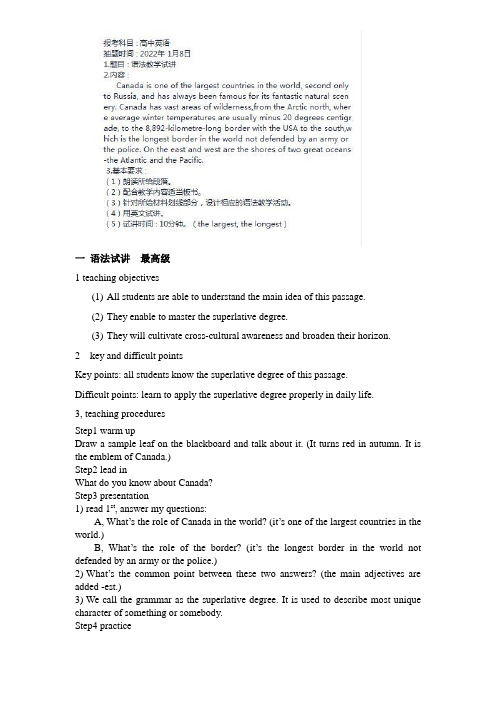
一语法试讲最高级1 teaching objectives(1)All students are able to understand the main idea of this passage.(2)They enable to master the superlative degree.(3)They will cultivate cross-cultural awareness and broaden their horizon.2 key and difficult pointsKey points: all students know the superlative degree of this passage.Difficult points: learn to apply the superlative degree properly in daily life.3, teaching proceduresStep1 warm upDraw a sample leaf on the blackboard and talk about it. (It turns red in autumn. It is the emblem of Canada.)Step2 lead inWhat do you know about Canada?Step3 presentation1)read 1st, answer my questions:A, What’s the role of Canada in the world? (it’s one of the largest countries in the world.)B, What’s the role of the border? (it’s the longest border in the world not defended by an army or the police.)2)What’s the common point between these two answers? (the main adjectives are added -est.)3)We call the grammar as the superlative degree. It is used to describe most unique character of something or somebody.Step4 practiceCan you say the difference of the third line and circle?1 2 31 2 3Step5 productionPlease make a discussion about the unique things of China.(The longest river is Yangtze River in China. The biggest province is Tibet in China. The noblest teacher is Confucius.)Step6 summaryWe have known something about Canada and the grammar-the superlative degree. We should know more about foreign countries to make our life more colourful and our brain more thoughtful.Step7 homeworkPlease share the things you like best with your friends.Step8 blackboard designThe superlative degreeCanada is one of the largest countries. largestSuperlative degree The border is the longest. longest1 the + monosyllabic adjectives + est2 the most + polysyllabic adjectives二语法教学时间短语1 teaching objectives1)All students are able to understand the main idea of this passage.2)They enable to master the usage of preposition of different time.3)They will be more grateful to the modern life and cherish time.2 key and difficult pointsKey points: all students know the different usage about the preposition of time. Difficult points: learn to use proper preposition to show different time in daily life. 3, teaching proceduresStep1 warm upShow a smart phone, ask and answer.1)What’s it?2)When was it invented?3)What are the advantages of it?Step2 lead inBefore the smart phone invented, what did people use to keep voice for a long time? (They used a recording to keep voice for a long time.)Step3 presentation1)read 1st, answer my questions:A, When did the first recording come to the world? (in 1877)B, When did the first long-play recording come to the market? (in 1958)C.How long did the first recording play?(for two minutes)D.Which phrase about time was not picked up? (at that time)2)Read 2nd, find out the different prepositions before some time and speak out their different usage.(In front of the time of some year, the preposition is “in”. In front of a period of time, the preposition is “for”. And before some specific time, the preposition is “at”. Therefore, depending on different length of time, we use different prepositions to modify it.)Step4 practiceLook at your curriculum schedule, and tell me when and how long you learn English. Step5 productionPlease do a survey about your new year resolutions.(In 2022, I will study harder and keep myself healthier. I will study English for 1 hour per day. I will run 2000 meters in one week. At 21:00, I will go to bed every day.) Step6 summaryWe have known something about recording and the different usage of preposition before some time. We should be grateful to inventors for our convenient life and cherish time.Step7 homeworkPlease write your routine of a day about your last summer vacation.Step8 blackboard designEarly history of sound recordersin 1877, in 1958 in + yearPreposition before time at that time at+ specific timefor two minutes for +a period of time三语法教学定语从句1 teaching objectives1)All students are able to understand the main idea of this passage.2)They enable to distinguish the different parts of speech in a complex sentence and know what the attributive clause is and how to use the attributive clause.3)They will be more sensitive to different kind of literature.2 key and difficult pointsKey points:They enable to distinguish the different parts of speech in a complex sentence.Difficult points: learn to acknowledge what the attributive clause is and how to use the attributive clause in daily life.3, teaching proceduresStep1 warm up and lead inEnjoy a song named “dream is possible”. ask and answer1)Do you like music?2)What other kind of culture works do you know? (poetry, drama...)Step2 presentationread the passage 1st , answer my questions:A, What is a poetry? (it is a writing that usually has a rhythm that is repeated.) B, What is a drama? (it is a writing that tells a story through action and speech. )C.What is a best-seller? ( a book which is popular is called a best-seller.)Read the passage 2nd, find out the common points of these answers and analyse the 1st answer about the part of speech.1.(they are all complex sentences. And they all contain some attributive clauses. In the first answer “it is a writing that usually has a rhythm that is repeated”, “that usually has a rhythm”is an attributive clause that modify the antecedent noun “writing” to explain it with some bonus information. And “that is repeated” is also an attributive clause to modify the antecedent noun “rhythm”to explain it with some detail information. The two words of “that”act as relative pronoun. Therefore, the attributive clause structure is antecedent noun + relative pronoun + bonus information.)2.Analyse the left attributive clauses and point out what they are and which part of speech are.Step4 practiceLook at me, and describe me with some attributive clauses. ( She is an English teacher who wears black coat.)Step5 productionPlease make a discussion about your favourite culture works and why.(I love the book that is named Journey to West best. Because Monkey King is clever who always defeat devils.)Step6 summaryWe have known some different culture works and the usage of the attributive clause. We should keep sensitive to different culture works and enjoy their beauty. Step7 homeworkPlease introduce a story or poem or drama to your friends with attributive clauses.Step8 blackboard designThe attributive clauseIt is a writing that usually has a rhythm that is repeated.antecedent noun + relative pronoun + bonus information。
无生试讲语法课定语从句

无生试讲语法课定语从句(实用版)目录1.无生试讲语法课的概述2.定语从句的定义和作用3.定语从句的种类和构成4.定语从句的用法和注意事项5.练习和应用正文一、无生试讲语法课的概述无生试讲语法课是一种针对语法知识的教学方法,通过模拟实际教学环境,让学生在没有学生的情况下进行语法讲解。
这种方法既能锻炼学生的表达能力,又能使学生更深入地理解语法知识。
在无生试讲中,讲解的语法点应当具有典型性、实用性和普适性,以便学生能够通过这一环节的训练,全面提升自己的语法水平。
二、定语从句的定义和作用定语从句是英语语法中的一种从句类型,其主要作用是用来修饰名词或代词,使其更具体、明确。
定语从句通常由关系词(如 which、that、who、whom、whose 等)引导,位于被修饰名词或代词之前。
三、定语从句的种类和构成1.限定性定语从句:这种定语从句对被修饰的名词或代词起限制作用,相当于汉语中的“……的”。
限定性定语从句通常由关系代词(如 which、that)或关系副词(如 where、when、why 等)引导。
2.非限定性定语从句:这种定语从句对被修饰的名词或代词不起限制作用,相当于汉语中的“……的其中”。
非限定性定语从句通常由关系代词(如 which、whom、whose 等)引导,位于被修饰名词或代词之后。
四、定语从句的用法和注意事项1.用法:定语从句可以用来修饰人、物、地点、时间等名词或代词,使它们更具体、明确。
在英语写作和口语中,定语从句是常见的表达方式,能够提高表达的准确性和连贯性。
2.注意事项:(1)关系词的选择要根据被修饰的名词或代词的性质和作用来决定。
(2)关系词在定语从句中要充当一定的成分,如主语、宾语、表语等。
(3)非限定性定语从句不能省略关系词。
五、练习和应用通过以上讲解,相信你对定语从句已经有了一定的了解。
现在,请尝试根据下面的汉语句子,用定语从句进行改写:1.我昨天在图书馆借了一本书。
高中定语从句怎么试讲
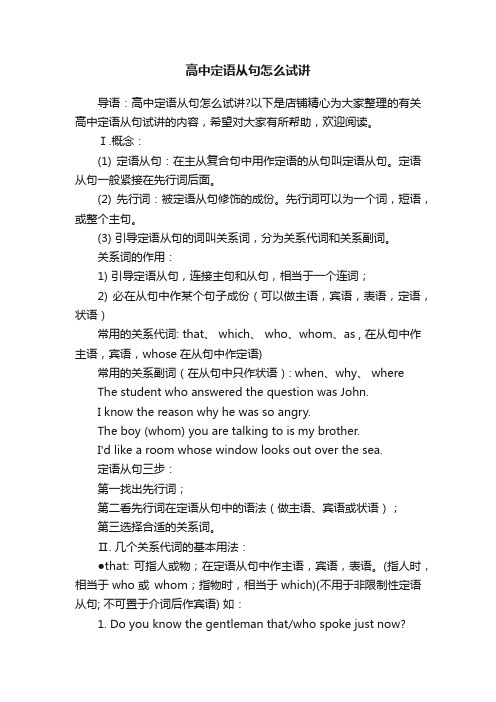
高中定语从句怎么试讲导语:高中定语从句怎么试讲?以下是店铺精心为大家整理的有关高中定语从句试讲的内容,希望对大家有所帮助,欢迎阅读。
Ⅰ.概念:(1) 定语从句:在主从复合句中用作定语的从句叫定语从句。
定语从句一般紧接在先行词后面。
(2) 先行词:被定语从句修饰的成份。
先行词可以为一个词,短语,或整个主句。
(3) 引导定语从句的词叫关系词,分为关系代词和关系副词。
关系词的作用:1) 引导定语从句,连接主句和从句,相当于一个连词;2) 必在从句中作某个句子成份(可以做主语,宾语,表语,定语,状语)常用的关系代词: that、 which、 who、whom、as , 在从句中作主语,宾语,whose在从句中作定语)常用的关系副词(在从句中只作状语): when、why、 whereThe student who answered the question was John.I know the reason why he was so angry.The boy (whom) you are talking to is my brother.I'd like a room whose window looks out over the sea.定语从句三步:第一找出先行词;第二看先行词在定语从句中的语法(做主语、宾语或状语);第三选择合适的关系词。
Ⅱ. 几个关系代词的基本用法:●that: 可指人或物;在定语从句中作主语,宾语,表语。
(指人时,相当于who或whom;指物时,相当于which)(不用于非限制性定语从句; 不可置于介词后作宾语) 如:1. Do you know the gentleman that/who spoke just now?2. You can take anything ( that) you like.3. What is the question (that/which) they are talking about?4. Here is the man ( who/whom/that ) you want to see.5. She's no longer the girl ( that) she used to be before.●which: 指物;在定语从句中作主语,宾语,表语,定语。
高中定语从句试讲教案

You must do what others don't want to do today, so that tomorrow you can have things that others can't.精品模板助您成功!(页眉可删)高中定语从句试讲教案高中定语从句试讲教案应该要怎么写呢?我们不妨一起来参考下范文吧!以下是为您搜集整理提供到的高中定语从句试讲教案内容,希望对您有所帮助!欢迎阅读参考学习!高中定语从句试讲教案定语从句基本概念在复合句中,修饰名词或代词的从句叫定语从句。
引导定语从句的词叫关系词。
被修饰的名词或代词叫先行词。
定语从句一般放在先行词的后面。
2定语从句的关系词引导定语从句的关系词有关系代词和关系副词。
常见的关系代词包括that, which, who(宾格whom,所有格whose),as 等。
关系副词包括where, when, why等。
关系代词和关系副词放在先行词及定语从句之间起连接作用,同时又作定语从句的重要成分。
3定语从句的分类根据定语从句与先行词的关系,定语从句可分为限制性定语从句及非限制性定语从句。
1.限制性定语从句紧跟先行词,主句与从句不用逗号分开,从句不可省去。
例如:Any manthat / who has a sense of dutywon’t do such a thing.任何有责任感的人都不会做这样的事。
2.非限制性定语从句主句与从句之间有逗号分开,起补充说明作用,如省去,意思仍完整。
例如:The house,which we bought last month,is very nice.这幢房子很漂亮,是我们上个月买的.注意:非限定性定语从句中不能使用关系代词 that。
4关系代词的用法1.thatthat既可以用于指人,也可以用于指物。
在定语从句中作主语、宾语或表语,作宾语可省略。
例如:Mary likes musicthat is quiet and gentle.玛丽喜欢轻柔的音乐。
高中英语定语从句十分钟试讲.docx
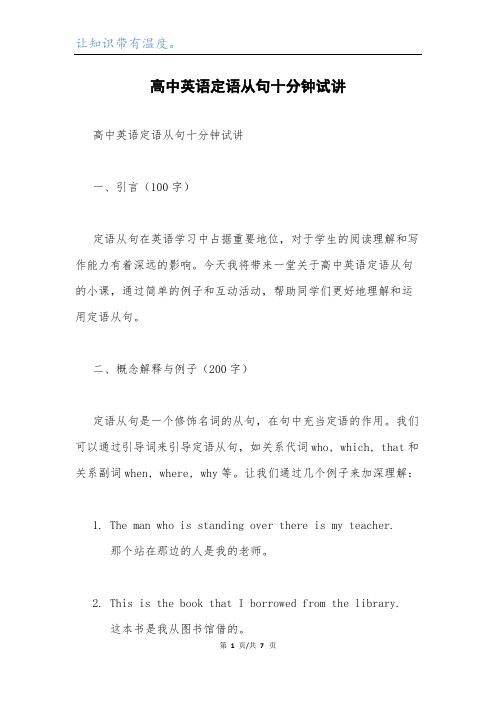
高中英语定语从句十分钟试讲高中英语定语从句十分钟试讲一、引言(100字)定语从句在英语学习中占据重要地位,对于学生的阅读理解和写作能力有着深远的影响。
今天我将带来一堂关于高中英语定语从句的小课,通过简单的例子和互动活动,帮助同学们更好地理解和运用定语从句。
二、概念解释与例子(200字)定语从句是一个修饰名词的从句,在句中充当定语的作用。
我们可以通过引导词来引导定语从句,如关系代词who, which, that和关系副词when, where, why等。
让我们通过几个例子来加深理解:1. The man who is standing over there is my teacher.那个站在那边的人是我的老师。
2. This is the book that I borrowed from the library.这本书是我从图书馆借的。
3. The place where we met for the first time is now a shopping mall.我们第一次见面的地方现在是一个购物中心。
三、定语从句的使用方法(300字)在句子中引入定语从句时,需要注意以下几点:1. 关系代词的使用:- who用于指人,作主语或宾语;- which用于指物,作主语或宾语;- that可以指人或物,作主语或宾语。
2. 关系副词的使用:- when用于时间,修饰表示时间的名词;- where用于地点,修饰表示地点的名词;- why用于原因,修饰表示原因的名词。
3. 定语从句的位置:- 在句中作定语的从句一般紧跟在被修饰名词之后。
四、练习与互动(200字)为了加深大家对定语从句的理解,我们将进行一些练习与互动活动。
1. 请同学们根据括号中的提示翻译下列句子:- The girl (who/that plays the piano) is my sister.(括号中选择who或that)- The reason (why/which) I like this movie is its interesting plot.(括号中选择why或which)2. 在下列句子中找出定语从句,并指出其在句中的成分:- The house that stands at the corner is very old.- July 13th is the day when we celebrate National Day.五、定语从句的错误常见问题及纠正方法(200字)在学习定语从句时,同学们经常会犯一些常见的错误。
高中英语语法篇——定语从句(试讲).ppt

I will tell you a story that is very interesting.
The book that is on the desk was written by my grandfatrher.
(4)由which引导的定语从句。 关系代词which一般指物,在从句中作
Tom married a girl whose name(the name of which) was Jane.
The End Thank You!
Tom’s father. It was an old house where Tom was
born. Tom liked to write stories and Jane loved all the stories that Tom wrote. They had 5 children, of whom 3 were boys. The children were very clever, which made Tom very happy. All the children went to college, as their parents expected.
1. 关系代词的用法 (1)由who引导的定语从句 关系代词who只能指人,在从句中作主
语和宾语。例如:
It is about a young man who was called Tom.
The man who is shaking hands with my father is a policeman.
They rushed over to help the man whose car had broken down.
高一英语定语从句试讲
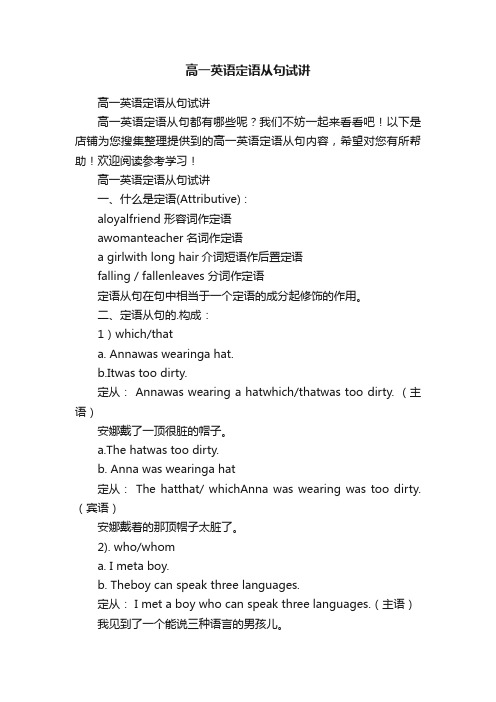
高一英语定语从句试讲高一英语定语从句试讲高一英语定语从句都有哪些呢?我们不妨一起来看看吧!以下是店铺为您搜集整理提供到的高一英语定语从句内容,希望对您有所帮助!欢迎阅读参考学习!高一英语定语从句试讲一、什么是定语(Attributive) :aloyalfriend 形容词作定语awomanteacher 名词作定语a girlwith long hair介词短语作后置定语falling / fallenleaves 分词作定语定语从句在句中相当于一个定语的成分起修饰的作用。
二、定语从句的.构成:1)which/thata. Annawas wearinga hat.b.Itwas too dirty.定从: Annawas wearing a hatwhich/thatwas too dirty. (主语)安娜戴了一顶很脏的帽子。
a.The hatwas too dirty.b. Anna was wearinga hat定从:The hatthat/ whichAnna was wearing was too dirty.(宾语)安娜戴着的那顶帽子太脏了。
2). who/whoma. I meta boy.b. Theboy can speak three languages.定从: I met a boy who can speak three languages.(主语)我见到了一个能说三种语言的男孩儿。
a. Theboy can speak three languages.b. I met a boy.定从:The boy whom/ who I met can speak three languages.(宾语)我见到的男孩儿能说三种语言。
3. whosea. We saw some people.b. Their arms had broken.定从: We saw some people whose arms had broken.我们看见了一些手臂受了伤的人。
定语从句试讲高中教案模板
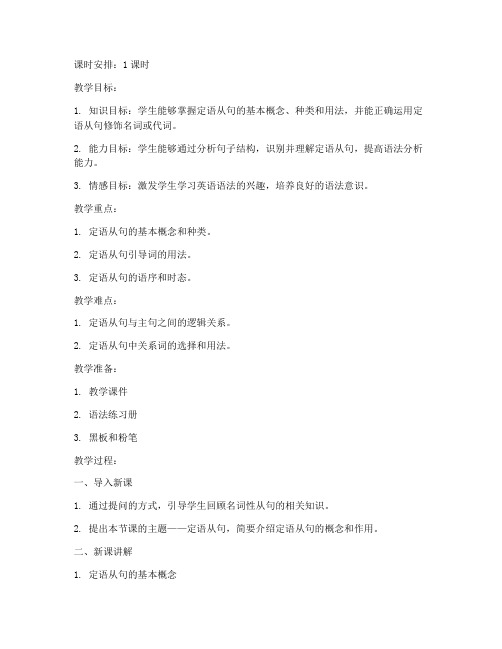
课时安排:1课时教学目标:1. 知识目标:学生能够掌握定语从句的基本概念、种类和用法,并能正确运用定语从句修饰名词或代词。
2. 能力目标:学生能够通过分析句子结构,识别并理解定语从句,提高语法分析能力。
3. 情感目标:激发学生学习英语语法的兴趣,培养良好的语法意识。
教学重点:1. 定语从句的基本概念和种类。
2. 定语从句引导词的用法。
3. 定语从句的语序和时态。
教学难点:1. 定语从句与主句之间的逻辑关系。
2. 定语从句中关系词的选择和用法。
教学准备:1. 教学课件2. 语法练习册3. 黑板和粉笔教学过程:一、导入新课1. 通过提问的方式,引导学生回顾名词性从句的相关知识。
2. 提出本节课的主题——定语从句,简要介绍定语从句的概念和作用。
二、新课讲解1. 定语从句的基本概念- 介绍定语从句的定义,即修饰名词或代词的从句。
- 强调定语从句的作用,即限定或说明先行词。
2. 定语从句的种类- 关系代词引导的定语从句:who, whom, whose, which, that。
- 关系副词引导的定语从句:when, where, why。
3. 定语从句引导词的用法- 介绍关系代词和关系副词的用法,包括先行词的选择、引导词的选择和位置等。
- 通过例句讲解关系代词和关系副词在定语从句中的具体用法。
4. 定语从句的语序和时态- 讲解定语从句中的语序和时态与主句的关系。
- 强调定语从句中时态的选用要符合逻辑和语境。
三、课堂练习1. 完成语法练习册中的定语从句练习题。
2. 学生相互检查答案,教师巡视指导。
四、课堂小结1. 总结本节课所学内容,强调定语从句的基本概念、种类、引导词用法、语序和时态。
2. 提醒学生在日常学习中注意运用定语从句,提高英语表达能力。
五、布置作业1. 完成语法练习册中的相关练习题。
2. 预习下一节课的内容。
教学反思:本节课通过讲解、练习和总结的方式,使学生掌握了定语从句的基本概念、种类和用法。
高中英语试讲教案——定语从句

定语从句A t t r i b u t i v e C l a u s e之关系副词篇教学目标:掌握由关系副词引导的定语从句教学重点:定语从句中的关系副词why, when, where教学难点:关系词的选择授课对象:高三授课人姓名:王瑶教学过程一、定语从句相关基础知识1. 定语从句2. 定语从句结构:主句先行词+关系词+从句3. 先行词4. 关系词/引导词:连接/引导;做成分5. 关系词分类:关系代词 that,which,who, whom, whose →←从句中做主,宾,表,宾补;关系副词why, when, where →←从句中做状语二、定语从句之关系副词1. 关系副词why1 在从句中做原因状语,修饰从句谓语动词;先行词必须是表示原因的名词,常用的就两个reason, causee.g.1This is the reason why I didn’t come here.2why作关系词引导定语从句,先行词一定是reason/cause;但reason/cause是先行词时,关系词不一定就是why,可能是that/whiche.g. ①The reason ________ he gave me was unknown.②The reason ________ he didn’t attend the meeting was unknown.3如何选择关系词解题路径:区分关系代词和关系副词,分析从句中的成分,判断关系词在从句中充当的成分,从而判断是关系代词还是关系副词a. 通过翻译找准先行词b. 判断从句中的谓语动词是否及物;及物动词没有带宾语,说明关系词在从句中做宾语,因此是关系代词注意spend,visit是及物动词,give后可接双宾语<人是间接宾语,不能独立存在>,talk 是不及物动词4why引导的定语从句时,先行词可省略因此例句1可以改为:This is why I didn’t come here.小结:why引导的定语从句比较简单,记住reason和cause2. 关系副词when1 在从句中做时间状语,修饰从句谓语动词;先行词必须是表示时间的名词,常用的例如hour, day, year, time等e.g. 2 I never forget the day when we first met in the park.2 先行词是时间名词,关系词不一定是whene.g. ① The days ______ we spent in London is unforgettable.② The days ______ we stayed in London is unforgettable.小结:关系词when的用法,先行词是否为时间名词,分析从句句子成分;从句缺少时间状语用when, 缺少其他成分用that等即先行词是时间名词,关系词不一定是when关系词是when,先行词一定是时间名词3.关系副词where1 在从句中做地点状语,修饰从句谓语动词;先行词通常是表示地点的名词,常用的例如house, factory, palce等e.g. 3 I get out of the house where I was born.2 先行词是地点名词,关系词不一定是wheree.g. ① This is the town ______ I spent my childhood.② This is the town ______ I told you about.判断方法仍然是看关系词在定语中充当的成分3where引导定语从句,先行词可能是隐含地点意义的抽象名词必须舍我其谁vs通常还有例外换句话说,where引导的定语从句,先行词不一定是表示地点的名词,但是这类名词隐含地点意义,通常是抽象名词,例如dream, case, point, stage, situation, occasion, business 等e.g. ①He has reached the point地步/程度______ a change is needed.that/which/where/who② Can you think out a situation 情况/情形_____ this phrase can be used.小结:a.确认关系词在从句中是否作状语,再确认先行词是否为地点名词b.谨记where引导的定语从句中可能出现“离谱”的先行词先行词是地点名词,关系词不一定是where关系词是where,先行词也不一定是地点名词三个关系副词中where用法最复杂4. 关系副词有how吗how 不可以作为表示方式的关系副词,在英语中若要表示方式,用以下四种句型1)the way +从句2the way that +从句3the way in which +从句4the manner that +从句e.g. 4 I don’t like ______ you speak to her.A the wayB the way in thatC the way whichD the way of whichC whichD where三、四、造句要求:定语从句中至少再包含另外一个定语从句e. g. I’ll never forget the day when we first met in the park where is full of pandas whose eyes are black that is my sister’s favorite.。
无生试讲语法课定语从句

无生试讲语法课定语从句摘要:一、引言1.介绍无生试讲语法课的背景和目的2.说明本次讲解的主题:定语从句二、定语从句的概念和作用1.定义定语从句2.解释定语从句的作用和用途三、定语从句的分类1.限制性定语从句2.非限制性定语从句四、定语从句的引导词1.限制性定语从句的引导词a.关系代词:who, whom, whose, that, whichb.关系副词:when, where, why2.非限制性定语从句的引导词a.关系代词:who, whom, whose, that, whichb.关系副词:when, where, why五、定语从句的实例分析1.限制性定语从句实例分析2.非限制性定语从句实例分析六、定语从句的难点与易错点1.难点解析:定语从句与同位语从句的区分2.易错点提示:避免使用错误的引导词和语序七、总结与回顾1.总结定语从句的相关知识点2.回顾本次讲解的重点内容正文:【引言】在我国的中文教学过程中,无生试讲语法课是一种重要的教学手段。
通过这种形式,学生可以更加深入地理解和掌握语法知识。
本次讲解的主题是定语从句,这是一种在句子中起修饰作用的从句,能够帮助我们更加准确地表达思想。
【定语从句的概念和作用】定语从句是用来修饰名词或代词的从句,通常由关系代词或关系副词引导。
它在句子中的作用是进一步说明和解释名词或代词的属性,使句子更加具体、明确。
【定语从句的分类】定语从句可以分为限制性定语从句和非限制性定语从句。
限制性定语从句是起限定作用的从句,它紧跟在被修饰词之后,不能拆分。
非限制性定语从句是起补充作用的从句,通常位于句子的末尾,可以用逗号隔开。
【定语从句的引导词】限制性定语从句和非限制性定语从句都可以使用关系代词(如who,whom, whose, that, which)和关系副词(如when, where, why)来引导。
在选择引导词时,需要根据定语从句的具体作用和位置来判断。
【定语从句的实例分析】这里给出两个实例,分别展示限制性定语从句和非限制性定语从句的使用:限制性定语从句实例:我昨天见到的那个女孩是我的同学。
定语从句试讲10分钟.docx
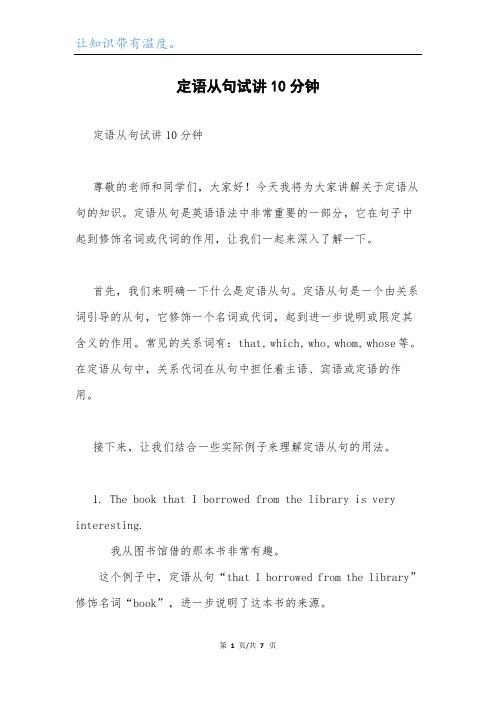
定语从句试讲10分钟定语从句试讲10分钟尊敬的老师和同学们,大家好!今天我将为大家讲解关于定语从句的知识。
定语从句是英语语法中非常重要的一部分,它在句子中起到修饰名词或代词的作用,让我们一起来深入了解一下。
首先,我们来明确一下什么是定语从句。
定语从句是一个由关系词引导的从句,它修饰一个名词或代词,起到进一步说明或限定其含义的作用。
常见的关系词有:that, which, who, whom, whose等。
在定语从句中,关系代词在从句中担任着主语、宾语或定语的作用。
接下来,让我们结合一些实际例子来理解定语从句的用法。
1. The book that I borrowed from the library is very interesting.我从图书馆借的那本书非常有趣。
这个例子中,定语从句“that I borrowed from the library”修饰名词“book”,进一步说明了这本书的来源。
2. The student who won the competition is my friend.赢得比赛的学生是我的朋友。
这个例子中,定语从句“who won the competition”修饰名词“student”,进一步说明了这个学生的身份。
3. The house where she lived for many years has been sold.她居住了多年的房子已经被卖掉了。
这个例子中,定语从句“where she lived for many years”修饰名词“house”,进一步说明了这个房子的位置。
定语从句可以起到进一步限定名词或代词的作用,使句子更加清晰和具体。
在使用定语从句时,我们需要注意一些语法规则。
首先,关系词在定语从句中担任不同的角色。
如果关系词在定语从句中充当主语,那么可以省略;如果关系词在定语从句中充当宾语,或者修饰介词的宾语,那么就不能省略。
高中定语从句试讲课简洁版

高中定语从句试讲课简洁版高中定语从句说课稿1一、设计背景1.初步掌握及运用定语从句,如让学生用定语从句来完成对人物喜欢的人物进行描述,如I like music that I can dance to. She is the only one who’s studying French.等。
2.本课的学习任务就是能初步掌握及运用定语从句,为了使学生顺利地完成教学任务,教师以学生为主体,为学生设计了几个以他们的认知水平出发的符合生活实际的他们感兴趣的一环扣一环的子任务,每个子任务紧紧围绕总任务展开,再深入,在一个一个完成任务的活动中培养学生的能力。
二、教学目标(1)语言目标:用定语从句更自由地描述和谈论人和事。
在活动中,锻炼了学生的听力和口语表达能力,培养了学生的观察力、想象力和创造力。
(2)情感目标:促进学生之间的积极合作与交流,发展他们之间的友谊。
2.教学方法:多媒体的运用能创设真实的语言情景,学生也很感兴趣,极大地鼓动了学生学习英语的积极性,而且呈现在课堂上能使教学更生活化,也更直观和具体。
三、教学方法以学生为中心,利用多媒体辅助教学,通过理解、归纳、总结和讨论来帮助学生学习定语从句。
由于本课是学生第一次系统地学习定语从句,因此有必要使学生初步掌握定语从句。
四、学法指导:自主学习、合作学习五、教学过程第一环节:观察以下例句:1.The red pen is broken.2.The pen on the desk is broken.3.The pen that I bought yesterday is broken.介绍:通过对定语的理解,介绍定语和定语从句的概念。
定语:当修饰语是句子时,用来修饰名词或代词的词、短语或句子称为定语从句。
通常放在它所修饰的词之后,这个被修饰的词叫做先行词,引导定语从句的相关词是关系代词和关系副词。
关系代词可以用作主语、宾语、定语等。
在定语从句中,关系副词只能在定语从句中作状语。
定语从句试讲教案
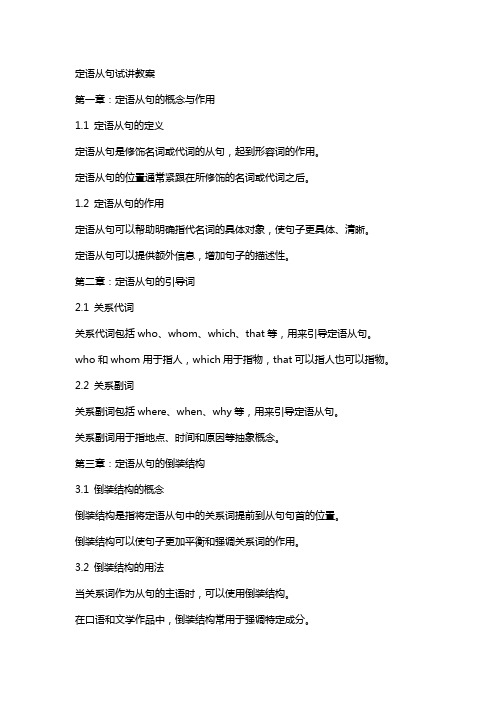
定语从句试讲教案第一章:定语从句的概念与作用1.1 定语从句的定义定语从句是修饰名词或代词的从句,起到形容词的作用。
定语从句的位置通常紧跟在所修饰的名词或代词之后。
1.2 定语从句的作用定语从句可以帮助明确指代名词的具体对象,使句子更具体、清晰。
定语从句可以提供额外信息,增加句子的描述性。
第二章:定语从句的引导词2.1 关系代词关系代词包括who、whom、which、that等,用来引导定语从句。
who和whom用于指人,which用于指物,that可以指人也可以指物。
2.2 关系副词关系副词包括where、when、why等,用来引导定语从句。
关系副词用于指地点、时间和原因等抽象概念。
第三章:定语从句的倒装结构3.1 倒装结构的概念倒装结构是指将定语从句中的关系词提前到从句句首的位置。
倒装结构可以使句子更加平衡和强调关系词的作用。
3.2 倒装结构的用法当关系词作为从句的主语时,可以使用倒装结构。
在口语和文学作品中,倒装结构常用于强调特定成分。
第四章:限定性定语从句与非限定性定语从句4.1 限定性定语从句限定性定语从句是必须存在于句子中的从句,起到必要的修饰作用。
限定性定语从句不能省略,否则句子意思不完整。
4.2 非限定性定语从句非限定性定语从句是非必须存在于句子中的从句,起到补充说明的作用。
非限定性定语从句可以省略,不会影响句子主要意思的表达。
第五章:定语从句的练习与运用5.1 定语从句的练习题提供一些练习题,让学生通过填空、改写等形式,运用定语从句的知识。
练习题应涵盖定语从句的不同引导词、倒装结构等知识点。
5.2 定语从句的实际运用让学生通过写作或口语表达的方式,运用定语从句来描述具体的人、物或场景。
鼓励学生多使用定语从句,提高其语言表达的准确性和丰富性。
第六章:关系代词who、whom和which的用法6.1 who的用法who用作主语,指代人。
举例:The man who is speaking to you is my teacher.6.2 whom的用法whom用作宾语,指代人。
2023年12月高中英语教资面试真题逐字稿高中英语语法课-定语从句
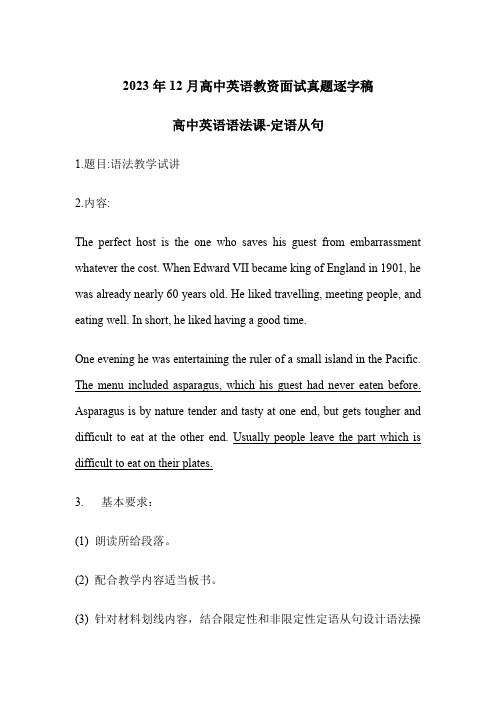
2023年12月高中英语教资面试真题逐字稿高中英语语法课-定语从句1.题目:语法教学试讲2.内容:The perfect host is the one who saves his guest from embarrassment whatever the cost. When Edward VII became king of England in 1901, he was already nearly 60 years old. He liked travelling, meeting people, and eating well. In short, he liked having a good time.One evening he was entertaining the ruler of a small island in the Pacific. The menu included asparagus, which his guest had never eaten before. Asparagus is by nature tender and tasty at one end, but gets tougher and difficult to eat at the other end. Usually people leave the part which is difficult to eat on their plates.3. 基本要求:(1) 朗读所给段落。
(2) 配合教学内容适当板书。
(3) 针对材料划线内容,结合限定性和非限定性定语从句设计语法操练的教学活动。
(4) 用英文试讲。
(5)试讲时间:10分钟。
逐字稿Restrictive and Non-Restrictive Adjective ClausesGood morning, students! Today, we're going to explore a fascinating topic: restrictive and non-restrictive adjective clauses. As you may have noticed, English sentences can become quite complex, and it's important to understand the different types of clauses to decode their meanings effectively.First, let's define what an adjective clause is. An adjective clause is a group of words that functions like an adjective, describing or modifying a noun or pronoun. Now, there are two main types of adjective clauses: restrictive and non-restrictive.Restrictive clauses are essential to defining or narrowing down the meaning of the noun or pronoun they modify. They provide crucial information and cannot be omitted without changing the intendedmeaning of the sentence.For example, in the sentence "Usually people leave the part which is difficult to eat on their plates" is a restrictive clause that restricts the meaning of the sentence by identifying a specific part of the asparagus that is difficult to eat. It cannot be omitted without changing the intended meaning of the sentence.On the other hand, non-restrictive clauses provide optional information about the noun or pronoun they modify. They are used to add additional details or clarify the context, but they can be omitted from the sentence without changing its basic meaning.For instance, in the sentence "The menu included asparagus, which his guest had never eaten before" is a non-restrictive clause that provides additional information about the asparagus on the menu. It could be omitted from the sentence without changing its meaning.Now that we've covered the differences between restrictive and non-restrictive clauses, let's put our knowledge into practice. I'll give you some examples of sentences with both types of clauses, and you'll analyze them, focusing on their functions within the context of each sentence. Remember, when analyzing clauses, it's important to consider whether they're essential to defining or narrowing down the meaning ofthe noun or pronoun they modify.Before we conclude today's lesson, let's recap what we've learned. We defined what an adjective clause is and distinguished between the two main types: restrictive and non-restrictive. We learned that restrictive clauses are essential in defining or narrowing down the meaning of the noun or pronoun they modify, while non-restrictive clauses provide optional information without changing the basic meaning of the sentence. In your homework, I'd like you to identify at least three examples of restrictive and non-restrictive clauses in a recent news article or a passage from your English textbook. Analyze and interpret these clauses, focusing on their functions within the context of each sentence, and write a short report on your findings.Remember, practice makes perfect! Use this knowledge in your own writing and speech, and don't be afraid to experiment with different types of clauses to enhance your communication skills.That's it for today's lesson! I hope you enjoyed learning about restrictive and non-restrictive adjective clauses. Don't forget to complete your homework and apply what you've learned in your daily language use. See you next time!。
高中英语试讲,定语从句

that&which 区别
不能用 that的情况: ① 引导非限制性定语从句; eg. He had failed in the maths exam , ( ) made his father very angry. ② 介词 + 关系代词。 eg. This is the room in(
) my father lived last year.
系 副词
1. 先行词是表示时间的名词,在定从中作时间状语,关系代词用 when eg. I can’t remember the date ( when ) he went abroad. 2. 先行词是表示地点的名词,在定从中作地点状语,关系代词用 where; 其中注意表示抽象概念的地点名词,如,situation、stage、 degree、point等表示方面或程度时,也需用where eg. This is the village (where ) Uncle Wang once lived. 3. 先行词是reason,在定从中作原因状语,关系代词用why eg. I don’t know the reason ( why ) he was late. 4.引导定语从句的关系副词也可以用“适当介词 + which”来代替。 eg. October 1, 1949 was the day when ( = on which ) the People’s Republic of China was founded.
关系 代词
1. 先行词是人,作主语,关系代词用who, that eg. The boy ( who ) is standing there is my cousin.
2. 先行词是人,作宾语,关系代词用 whom, who, that, eg. The man ( whom ) you met yesterday is Mr. Smith. 3. 先行词是物,作主语,关系代词用which, that eg . The train ( that ) has just left is for Guangzhou. 4. 先行词是物,作宾语,关系代词用which, that,或省略 eg. The book ( / ) you borrowed yesterday is really interesting. 5. 先行词是人、物,作定语,关系代词用whose eg. He is the professor ( whose ) name was Jackson.
试讲-英语定语从句详解

2. 若介词放在关系代词前,关系代词指人时用whom,不可用who或者that;指物时用which,不能用that;关系代词是所有格时用whose (1) The man with whom you talked is my friend. (T) 不可用who/that (2) The plane in which we flew to Canada is very comfortable. (T) 不可用in that 3. 当介词位于定语从句末尾时,可用 which/that(指物), who/whom/that(指人)作从句中介词的宾语.而且作介词宾语的关系代词可以省略。 (1) Dad is a person (whom/who/that) I can easily talk to. (2) Is this the play (which/that) you were talking about just now?
介词+关系代词引导的定语从句
关系代词在定语从句中做介词宾语时,从句常由介词+关系代词引导 介词的选用原则: 根据定语从句谓语动词的习惯搭配来决定。 This is the book on which I spent 8 dollars. This is the book for which I paid 8 dollars. (2) 根据先行词的习惯搭配来决定。 I remember the day on which I joined the Party. I remember the days during which I lived there
前置定语
后置定语
单词作定语时通常放在它所修饰的词之前,作前置定语。
短语和从句作定语时则放在所修饰的词之后,作后置定语。
定语从句试讲新颖教案模板

教学目标:1. 学生能够理解定语从句的概念和作用。
2. 学生能够识别并正确运用关系词引导定语从句。
3. 学生能够通过练习,提高运用定语从句进行句子改写的技能。
教学重点:1. 关系词的选用与搭配。
2. 定语从句的句子结构。
教学难点:1. 理解定语从句与主句之间的关系。
2. 关系词在定语从句中的正确使用。
教学准备:1. PPT课件,展示定语从句的相关知识。
2. 练习题,包括选择题、改错题和填空题。
3. 小组讨论卡,用于小组合作学习。
教学过程:一、导入1. 利用图片或视频,展示定语从句在日常生活中的应用,激发学生的学习兴趣。
2. 提问:你们知道什么是定语从句吗?它有什么作用?二、新课讲授1. 通过PPT展示定语从句的定义、作用和结构。
2. 举例讲解关系词的种类和用法,如who、whom、whose、which、that等。
3. 分析定语从句与主句之间的关系,强调先行词和关系词的对应关系。
4. 举例说明定语从句的句子结构,如“the book (which/that) you gave me is very interesting.”三、小组合作学习1. 分发小组讨论卡,每组讨论以下问题:- 定语从句与主句之间的关系有哪些?- 如何选择合适的关系词?- 定语从句的句子结构是怎样的?2. 各组派代表分享讨论结果。
四、练习巩固1. 学生完成PPT中的练习题,包括选择题、改错题和填空题。
2. 教师点评,指出学生的错误和不足,给予指导。
五、课堂小结1. 总结本节课所学内容,强调定语从句的重要性和用法。
2. 提醒学生在课后进行复习和练习。
六、作业布置1. 完成课后练习题,巩固所学知识。
2. 预习下一节课的内容,提前了解定语从句的用法。
教学反思:本节课通过新颖的教学方法和丰富的教学内容,帮助学生理解和掌握了定语从句的相关知识。
在教学过程中,注重学生的参与和互动,提高学生的学习兴趣。
同时,通过小组合作学习和练习巩固,使学生能够更好地掌握定语从句的用法。
高中定语从句试讲教案模板
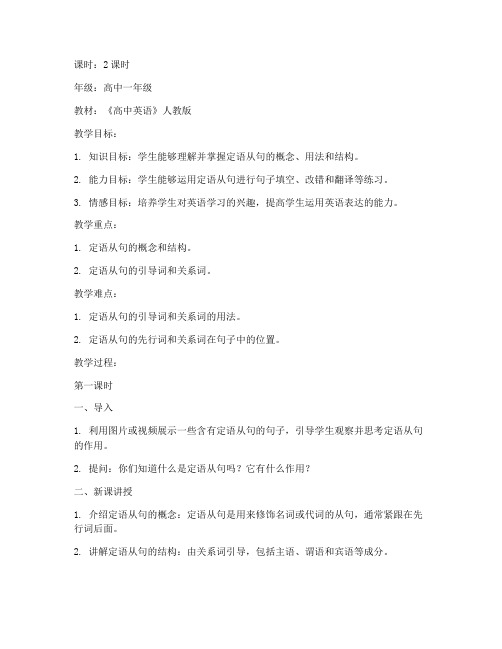
课时:2课时年级:高中一年级教材:《高中英语》人教版教学目标:1. 知识目标:学生能够理解并掌握定语从句的概念、用法和结构。
2. 能力目标:学生能够运用定语从句进行句子填空、改错和翻译等练习。
3. 情感目标:培养学生对英语学习的兴趣,提高学生运用英语表达的能力。
教学重点:1. 定语从句的概念和结构。
2. 定语从句的引导词和关系词。
教学难点:1. 定语从句的引导词和关系词的用法。
2. 定语从句的先行词和关系词在句子中的位置。
教学过程:第一课时一、导入1. 利用图片或视频展示一些含有定语从句的句子,引导学生观察并思考定语从句的作用。
2. 提问:你们知道什么是定语从句吗?它有什么作用?二、新课讲授1. 介绍定语从句的概念:定语从句是用来修饰名词或代词的从句,通常紧跟在先行词后面。
2. 讲解定语从句的结构:由关系词引导,包括主语、谓语和宾语等成分。
3. 举例说明定语从句的用法,如:The book that you gave me is very interesting.三、练习1. 划分句子成分,找出先行词和关系词。
2. 填空练习:根据句子意思,选择合适的定语从句填入空格。
四、小结1. 回顾本节课所学内容,强调定语从句的概念、结构和用法。
2. 布置课后作业,巩固所学知识。
第二课时一、复习1. 复习上节课所学内容,提问学生关于定语从句的问题。
2. 学生回答问题,教师点评。
二、新课讲授1. 讲解定语从句的引导词和关系词:a. 关系代词:who, whom, whose, that, whichb. 关系副词:where, when, why2. 举例说明引导词和关系词的用法,如:The girl who is standing there is my teacher.三、练习1. 划分句子成分,找出先行词、关系词和引导词。
2. 改错练习:找出句子中的错误,并改正。
3. 翻译练习:将中文句子翻译成含有定语从句的英文句子。
- 1、下载文档前请自行甄别文档内容的完整性,平台不提供额外的编辑、内容补充、找答案等附加服务。
- 2、"仅部分预览"的文档,不可在线预览部分如存在完整性等问题,可反馈申请退款(可完整预览的文档不适用该条件!)。
- 3、如文档侵犯您的权益,请联系客服反馈,我们会尽快为您处理(人工客服工作时间:9:00-18:30)。
No The attributive clause
Image 授课教师:姜洋
考点直击
定语从句是英语学习的重点和难点,也是高考的重点和 热点。重点注意以下几个方面:
1. 定语从句的种类和常见关系词的用法。 2. that引导的定语从句和同位语从句等名词性从句的区别。 3. “介词+关系代词”引导的定语从句的用法。 4. which,as引导的非限制性定于从句的的用法及区别。 5. 关系副词引导的定语从句与状语从句的区别。 6. 定语从句与强调句式和名词性从句的辨析。
A Short Story
I will tell you a story that is very interesting. It is about a young man who was called Tom.Tom married a girl whose name was Jane. Jane was the girl whom Tom loved. They lived in a house which was built by
知识网络构建
一.基本概念
1. 定语从句 在复合句中作定语,修饰名词或代词的
从句叫定语从句。 2. 先行词
被定语从句所修饰的名词或代词。 3. 关系代词和关系副词
定语从句的引导词。并在句子中充当句 子成分。
关系词的使用情况
先行词 物
人 人、物
引导词/关系词
引导词在从句中担任的成分
that,which
二.关ห้องสมุดไป่ตู้词的用法
1. 关系代词的用法 (1)由who引导的定语从句 关系代词who只能指人,在从句中作主
语和宾语。例如:
It is about a young man who was called Tom.
The man who is shaking hands with my father is a policeman.
Tom married a girl whose name(the name of which) was Jane.
The End
No ThanIkmYoua! ge
主语,也可作宾语。例如:
They lived in a house which was built by Tom’s father.
That is the pen (which) I lost yesterday.
(5)由whose引导的定语从句。 关系代词whose是who的所有格,在从句
中作主语,既可指人,又可指物。例如:
(2)由whom引导的定语从句 关系代词whom只能指人,是who的宾格,
在句中作宾语,口语中常省略。例如:
Jane was the girl whom Tom loved.
Mrs Smith (whom) you met yesterday is a friend of mine.
(3)由that引导的定语从句。 关系代词that在定语从句中既能作主语
They rushed over to help the man whose car had broken down.
Nobody wants the house whose roof has fallen in.
提示:“whose+名词”这一结构在定语从句 中既能作主语,又能宾语,whose的先行词 常用来指人,但有时也用来指具体事物和抽 象概念,这时可以与of which结构互换,次 序是“名词+of which”。例如:
Tom’s father. It was an old house where Tom was
born. Tom liked to write stories and Jane loved all the stories that Tom wrote. They had 5 children, of whom 3 were boys. The children were very clever, which made Tom very happy. All the children went to college, as their parents expected.
,又可作宾语;即可指人,又可指物。例如:
I will tell you a story that is very interesting.
The book that is on the desk was written by my grandfatrher.
(4)由which引导的定语从句。 关系代词which一般指物,在从句中作
主语、宾语、表语
whose
定语
No when,where,why who,that
状语 主语、宾语、表语
whose
定语
Image whom that
宾语、表语 主语、宾语、表语
注意:关系代词which ,as可以指代整个句子,在从句中作主语、 宾语、表语。定语从句中关系词的选择依据有两个:一是看先行 词是人还是物,二是看关系词在句子中担当什么成分。
